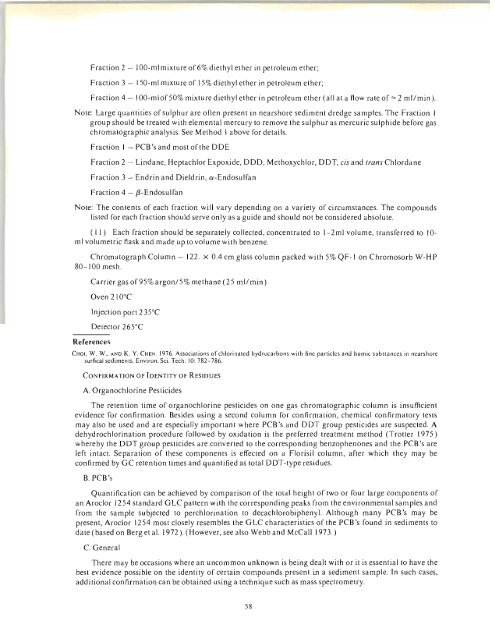You also want an ePaper? Increase the reach of your titles
YUMPU automatically turns print PDFs into web optimized ePapers that Google loves.
Fraction 2 - I OO-ml mixture of6% diethyl ether in petroleum ether;<br />
Fraction 3 - 150-ml mixture of 15% diethyl ether in petroleum ether;<br />
Fraction 4 - I OO-mlof 50% mixture diethyl ether in petroleum ether (all at a flow rate of"'" 2 ml/ min).<br />
Note: Large quantities of sulphur are often present in nearshore sediment dredge <strong>samples</strong>. The Fraction I<br />
group should be treated with elemental mercury to remove the sulphur as mercuric sulphide before gas<br />
chromatographic analysis. See Method I above for details.<br />
Fraction I - PCB's and most of the DOE<br />
Fraction 2 - Lindane, Heptachlor Expoxide, DOD, Methoxychlor, DDT, cis and trans Chlordane<br />
Fraction 3 - Endrin and Dieldrin, a-Endosulfan<br />
Fraction 4 - {3-Endosulfan<br />
Note: The contents of each fraction will vary depending on a variety of circumstances. The compounds<br />
listed for each fraction should serve only as a guide and should not be considered absolute.<br />
(II) Each fraction should be separately collected, concentrated to 1- 2ml volume, transferred to 10ml<br />
volumetric flask and made up to volume with benzene.<br />
Chromatograph Column - 122. X 0.4 cm glass column packed with 5% QF-I on Chromosorb W-HP<br />
80 -100 mesh.<br />
Carrier gas of95% argon/ 5% methane (25 ml/min)<br />
Oven 210°C<br />
Injection port 235°C<br />
Detector 265°C<br />
References<br />
CHOt, W. W., AND K. Y. CHEN. 1976. Associations of chlorinated hydrocarbons with fine particles and humic substances in nearshore<br />
surfieal sediments. Enviro n. Sci. Tech. 10: 782-786.<br />
CONFIRMATION OF IDENTITY OF RESIDUES<br />
A. Organochlorine Pesticides<br />
The retention time of organochlorine pesticides on one gas chromatographic column is insufficient<br />
evidence for confirmation. Besides using a second column for confirmation, chemical confirmatory tests<br />
may also be used and are especially important where PCB's and DDT group pesticides are suspected. A<br />
dehydrochlorination procedure followed by oxidation is the preferred treatment method (Trotter 1975)<br />
whereby the DDT group pesticides are converted to the corresponding benzophenones and the PCB's are<br />
left intact. Separation of these components is effected on a Florisil column, after which they may be<br />
confirmed by GC retention times and quantified as total DDT-type residues.<br />
B. PCB's<br />
Quantification can be achieved by comparison of the tOlal height of two or four large components of<br />
an ArocJor 1254 standard GLC pattern with the corresponding peaks from the environmental <strong>samples</strong> and<br />
from the sample subjected to perchlorination to decachlorobiphenyl. Although many PCB's may be<br />
present, ArocJor 1254 most closely resem bles the G LC characteristics of the PCB's found in sediments to<br />
date (based on Berg et al. 1972). (However, see also Webb and McCall 1973.)<br />
C. General<br />
There may be occasions where an uncommon unknown is being dealt with or it is essential to have the<br />
best evidence possible on the identity of certain compounds present in a sediment sample. In such cases,<br />
additional confirmation can be obtained using a technique such as mass spectrometry.<br />
58

















